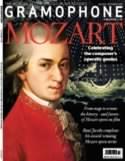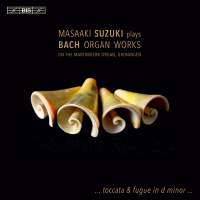Texte paru dans: / Appeared in: |
|
|
Outil de traduction (Très approximatif) |
|
|
Reviewer:
Jonathan Freeman-Attwood Of all the current doyens of modern Bach performance, Masaaki Suzuki knows no limits to his explorations. This is a dazzling recital (from a musician better known as a director-harpsichordist) discerningly assembled and held aloft by three great pillars: the ubiquitous Toccata and Fugue in D minor, BWV565; the Pièce d’orgue, BWV572, with Bach whisking the French 17th century from under its own nose; and, to conclude, the great Prelude and Fugue in E minor, BWV548 (the Wedge). If one’s reflexive default at the prospect of an organ recording – even an exquisitely curated Bach one – is one of dispassionate or nonchalant resistance, this recording is as likely to turn ears as any made.
Along the way, in a deftly balanced presentation of strikingly contrasting essays, Suzuki offers beautifully turned, reflective and buoyant readings of sui generis ‘concert’ works. The Pastorale, with its exquisite musette-like opening, whose subsequent C major movement trips along in a manner organists seem universally reluctant to pursue, is simply a pearl. Each of the four movements is sweetly devotional in nature, skilfully preparing the way for the highly distilled and contemplative variations on the chorale ‘O Gott, du frommer Gott’. The seasoned reflective qualities of Suzuki, heard to such memorable effect in his complete cantatas series, are reawakened in the stunningly voiced combinations of sounds from the Schnitger/Hinz in the Martinikerk in Groningen – one of Holland’s finest Baroque organs, restored to its former glory by Jürgen Ahrend during the 1970s and ’80s.
Unusual here, also, is how an emphatically non-organ-playing reviewer can effortlessly alight on the kinds of malleable Bachian conceits enjoyed habitually in the composer’s concertos, keyboard suites and vocal works. Great instrument aside, this is largely down to the judicious alchemy of Suzuki’s perception of how architecture and local colour can collide to mesmerising effect. The Fugue from the above-mentioned D minor is a case in point: the glistening parallel motion over the pedal at 3'20", often a bloated gesture, enticingly holds back to set up the rich-textured gravitas that follows. Inexorable momentum here is born of fervent authority, a virtuosity of combined effects without gratuitous excess.
The Canonic Variations on ‘Vom Himmel hoch’, written late in Bach’s life as a condition of membership of Lorenz Mitzler’s Corresponding Society of the Musical Sciences (hence the work’s proliferation of contrapuntal wizardry), can often leave the listener cold. Perhaps not surprisingly, Stravinsky was beguiled by the possibility of its intertwining lines in his inventive homage of 1956, with its suprapolyphonic interpolations. Suzuki’s performance will persuade you that Bach’s unsurpassed technique never obfuscates the essence of the chorale; its Christmas provenance is fragrantly atmospheric. The close, with its ingeniously compressed lines and the composer’s outrageous sign-off, literally spelling his name (B is B flat and H is B natural), is celebrated in some style by Suzuki.
But it’s the gripping drama and involvement in the large-scale works that remind one of Karl Richter in his most durable organ-playing legacy on Archiv from the 1960s (funnily enough, until recently, only available in Japan). Richter’s captivating direction and intensity, complete with an almost hypnotic abandon, is a touch more measured in Suzuki’s hands but no less effectively communicated.
The E minor
Prelude and Fugue is the greatest tour de force here, and arguably Bach’s most
ambitious single creation on the organ. Truly symphonic in grandeur, the work is
harnessed impressively by this exceptionally experienced Bachian. Granite-like
blocks of intensely chiselled harmonic progressions starting at 2'38" and
building to the last at 5'48" are studiously laid down, as if for posterity, and
yet there’s an underlying immediacy and restlessness in Suzuki’s rhetoric which
leads to thrillingly choppy waters in the Fugue. Only Samuil Feinberg’s
arrangement on the piano has lifted this piece completely out of its safe organ-istic
sphere – but I think it now has a partner in grandeur, flair and emotional risk.
And it’s on the organ. |
|
|
|
|
|
Cliquez l'un ou l'autre
bouton pour découvrir bien d'autres critiques de CD |
|




